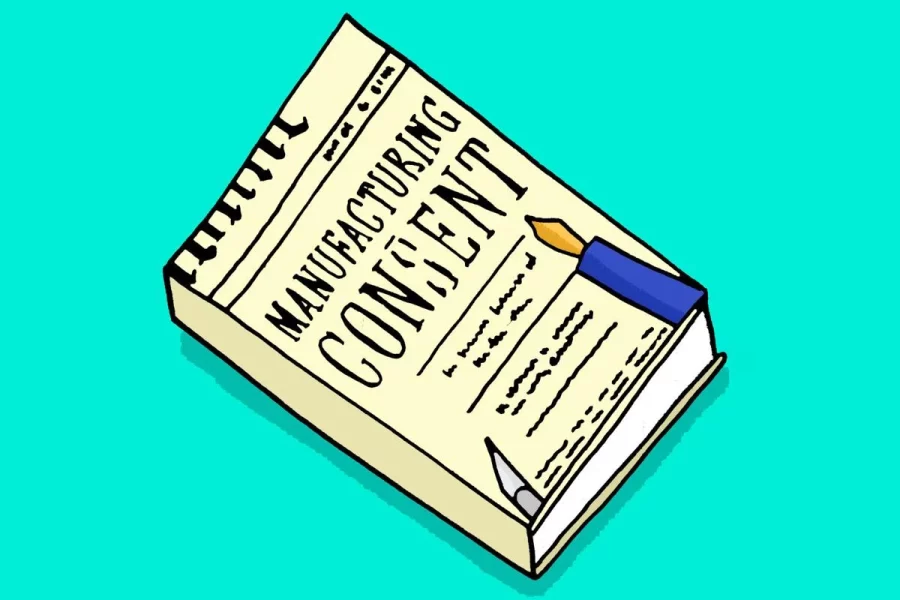From the perspective of communication, the media is not only a disseminator of information but also a constructor and defender of social rights. In their book, Noam Chomsky and Edward S. Herman reveal how media selectively propagate information to shape public opinion and behaviour in favour of elite interests. This theory aligns closely with agenda-setting, framing, and cultural hegemony theories, offering a critical lens to examine the relationship between media and power in both traditional and digital contexts.


Communication Theories and “Manufacturing Consent”
Chomsky and Herman proposed the core concept of “five filters”: media ownership, advertising dependence, information sources, counter pressure and ideological bias. The media influences the public’s perception of an issue’s importance by choosing the report’s content. Under the framework of “Manufacturing Consent”, the agenda-setting power of mainstream media often serves the interests of capital and political elites and avoids direct challenges to power. Goffman emphasized that the media not only needs to decide “what to report” but also “how to report”. The narrative manipulation in “Manufacturing Consent” formally packages the interests of the upper class as public interests through selective frameworks. The ruling class spreads ideology through cultural products, making its legitimacy regarded as common sense. Gramsci’s theory of cultural hegemony reveals this situation. Chomsky further pointed out that the media is a tool of this cultural hegemony, and its content-filtering mechanism strengthens the existing power relations.
US Invasion of Iraq
In 2003, the US government launched a war on the grounds that “Iraq possessed weapons of mass destruction”. The mainstream media played the role of “Manufacturing Consent”. For example, CNN and Fox News reported the threat of “weapons of mass destruction” on a large scale, placing it at the centre of public attention. At the same time, the discussion of the legitimacy and consequences of the war was marginalized. The news narrative adopted the framework of “war on terror” and “patriotism” to rationalize the war, and anti-war voices were regarded as “unpatriotic”. According to the research of Fairness & Accuracy In Reporting, experts who support the war account for more than 90% of the guests on TV programs, while anti-war experts are almost suppressed.
This case shows how the media guides the public’s attention, and the framing theory shows that the narrative selectively constructed by the media makes the public acquiesce to the legitimacy of the war. This also verifies Chomsky’s view that the media “serves the interests of the power elite”.

2016 U.S. Presidential Election

In the 2016 US presidential election, the algorithmic dominance of digital media and platform capitalism further strengthened “Manufacturing Consent.” Facebook and Twitter’s recommendation algorithms made the information that users were exposed to consistent with their existing biases, thus forming an “Echo Chamber.” At the same time, Russia’s online trolls spread fake news through social media to incite public sentiment, and the data company Cambridge Analytica used user data to accurately place political advertisements, thereby consolidating support for Trump.
Digital platforms amplify the influence of agenda-setting and framed reporting in their algorithmic settings, making the public more easily manipulated. ChomskyŌĆÖs ŌĆ£media control over elite interestsŌĆØ theory has been continued and upgraded in this new media environment.
Manufacturing Consent in the Digital Age
In traditional media, information is filtered by editors; on digital platforms, data is filtered by algorithms. Recommendation algorithms consolidate users’ existing views and make platforms a hotbed for spreading fake news. Nick Srnicek pointed out that digital platforms provide power elites with more accurate means of public manipulation by controlling user data and behaviour. This phenomenon continues “Manufacturing Content” in the digital age. Although digital media ostensibly provides diverse voices, the information flow is highly customized, making it more difficult for the public to access critical perspectives.
Countering ŌĆØManufacturing ConsentŌĆ£
- Critical Media Literacy. Educate the public on agenda-setting and framing methods and enhance information analysis skills. For example, through news source analysis, question the apparent “objectivity”.
- Support independent media. Independent media give the public alternative perspectives through diverse narratives and decentralized communication. For example, Democracy Now! and nonprofit news organization ProPublica provide more in-depth coverage of controversial social issues.
- Algorithm transparency and data power. Digital platforms are required to disclose algorithmic logic and protect users’ control over their own data to prevent data abuse.
Conclusion
Chomsky and Herman’s “Manufacturing Content” theory provides a critical tool for communication research, revealing how the media maintains power structures through agenda-setting and framing reports. In today’s digital age, the problems of traditional media are further magnified, and the public needs to be more vigilant about the hidden and complex nature of manipulation. Only by improving media literacy and supporting independent media can we break through the shackles of “Manufacturing Content” and pave the way for building a more fair and transparent information society.
Reference
FAIR (2003). ŌĆ£The Iraq War and the Failure of the U.S. Media.”
Herman, E. S., & Chomsky, N. (1988). Manufacturing Consent: The Political Economy of the Mass Media. New York: Pantheon Books.
Srnicek, N. (2017). Platform Capitalism. Cambridge: Polity Press.
Goffman, E. (1974). Frame Analysis: An Essay on the Organization of Experience. Cambridge: Harvard University Press.
Gramsci, A. (1971). Selections from the Prison Notebooks. London: Lawrence and Wishart.


This blog is a very insightful and structured analysis of the theory of ‘manufacturing consent’, especially when analysing the means of communication of both traditional and digital media, which is really enlightening. From the five filters to theories of agenda setting and framing to the link to cultural hegemony, the logic is clear and rich in case studies such as the Iraq War and the 2016 US election, which are very relevant examples of how the media serves the interests of elites.
However, the essay as a whole is on the theoretical side and a bit academic. For example, when talking about the algorithmic control of digital platforms, although it is thoroughly analysed, there is no specific elaboration on how the average user can detect and respond to these manipulations. Similarly, while supporting independent media is mentioned as one of the solutions, it could have been complemented with some practical examples of how independent media specifically influence public opinion or the challenges they face.
Overall, the article is a valuable interpretation of ‘manufacturing consent’, but it could have resonated more with everyday people if it had included more contextualised content between theories and solutions!
I thought your entry point was very special and interesting, and I never thought it would be from a power perspective. The concept of manufacturing consent is very important in communication, presentation, etc. This can greatly enhance our verbal persuasiveness.